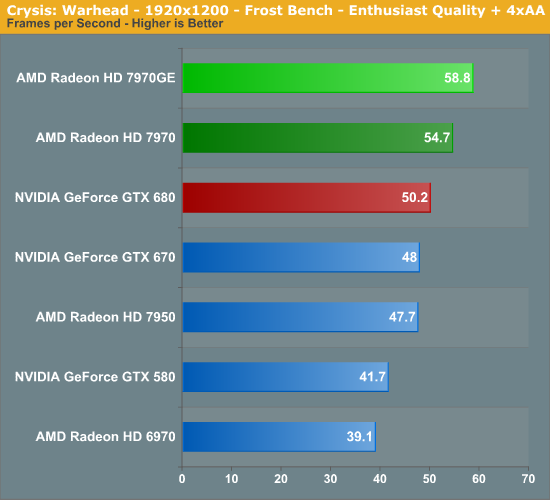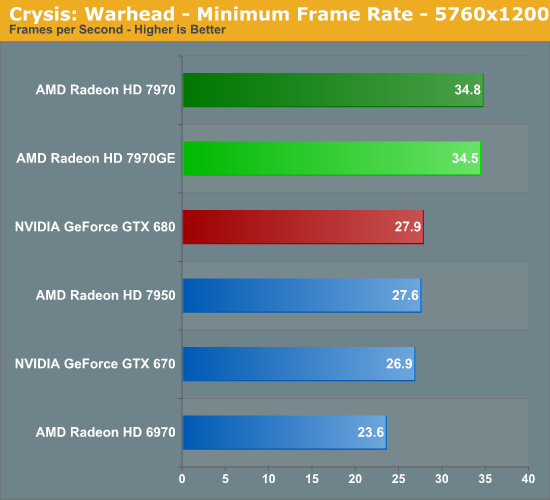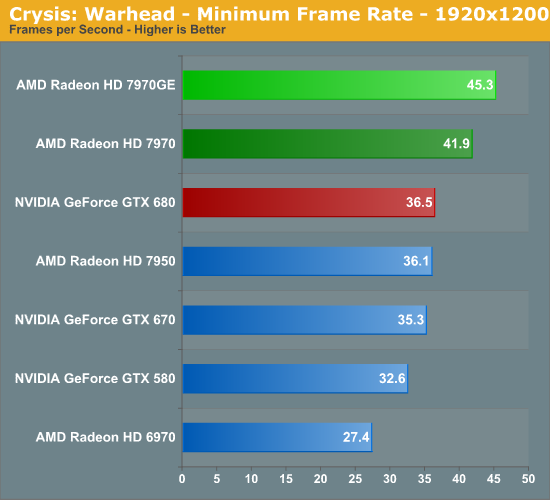AMD Radeon HD 7970 GHz Edition Review: Battling For The Performance Crown
by Ryan Smith on June 22, 2012 12:01 AM EST- Posted in
- GPUs
- AMD
- GCN
- Radeon HD 7000
Crysis: Warhead
Kicking things off as always is Crysis: Warhead. It’s no longer the toughest game in our benchmark suite, but it’s still a technically complex game that has proven to be a very consistent benchmark. Thus even four years since the release of the original Crysis, “but can it run Crysis?” is still an important question, and the answer continues to be “no.” While we’re closer than ever, full Enthusiast settings at a 60fps is still beyond the grasp of a single-GPU card.



Since the launch of the GTX 680 it’s been clear that Crysis is a game that favors AMD’s products and this is no clearer than with the 7970GE. AMD was already handily beating the GTX 680 here, most likely due to the GTX 680’s more limited memory bandwidth – so the faster 7970GE widens that gap even further. The 7970GE is a full 25% faster than the GTX 680 here at 2560 and is extremely close to hitting 60fps at 1920, which given Crysis’s graphically demanding nature is quite incredible, and for all practical purposes puts the 7970GE in its own category. Obviously this is one of AMD’s best games, but it’s solid proof that the 7970GE can really trounce the GTX 680 in the right situation.
As for the 7970GE versus the 7970, this is a much more straightforward comparison. We aren’t seeing the full extent of the 7970GE’s clockspeed advantage over the 7970 here, but the 7970GE is still at the lower bounds of its theoretical performance advantage over its lower clocked sibling with a gain of 8% at 2560. The 7970GE is priced some 16% higher than the 7970 so the performance gains aren’t going to keep pace with the price increases, but this is nothing new for flagship cards.



When it comes to minimum framerates the 7970GE further expands its lead. It’s now 35% faster than the GTX 680 (and just short of 30fps) at 2560, which neatly wraps up the 7970GE’s domination in Crysis. Even its performance lead versus the 7970 improves, with the 7970GE increasing its lead to 13%. A year ago NVIDIA and AMD were roughly tied with Crysis, but now AMD has clearly made it their game. So can it run Crysis? Yes, and a lot better than the GTX 680 can.










110 Comments
View All Comments
Ammaross - Friday, June 22, 2012 - link
So, since the 7970 GE is essentially a tweaked OCed 7970, why not include a factory-overclocked nVidia 680 for fairness? There's a whole lot of headroom on those 680s as well that these benches leave untouched and unrepresented.elitistlinuxuser - Friday, June 22, 2012 - link
Can it run pong and at what frame ratesRumpelstiltstein - Friday, June 22, 2012 - link
Why is Nvidia red and AMD Green?Galcobar - Friday, June 22, 2012 - link
Standard graph colouring on Anandtech is that the current product is highlighted in green, specific comparison products in red. The graphs on page 3 for driver updates aren't a standard graph for video card reviews.Also, typo noted on page 18 (OC Gaming Performance), the paragraph under the Portal 2 1920 chart: "With Portal 2 being one of the 7970GE’s biggest defEcits" -- deficits
mikezachlowe2004 - Sunday, June 24, 2012 - link
Computer performance is a big factor in deciding in purchase as well and I am disappointed to not see any mention of this in the conclusion. AMD blows nVidia out the water when it comes to compute performance and this should not be taken lightly seeing as games right now are implementing more and more compute capabilities in games and many other things. Compute performance has been growing and growing and today at a rate higher than ever and it is very disappointing to see no mention of this in Anand's conclusion.I use autoCAD for work all the time but I also enjoy playing games as well and with a workload like this, AMDs GPU provide a huge advantage over nVidia simply because nVidias GK104 compute performance is no where near that of AMDs. AMD is the obvious choice for someone like me.
As far as the noise and temps go, I personally feel if your spending $500 on a GPU and obviously thousands on your system there is no reason not tospend a couple hundred on water cooling. Water cooling completely eliminates any concern for temps and noise which should make AMDs card the clear choice. Same goes for power consumption. If you're spending thousands on a system there is no reason you should be worried about a couple extra dollars a month on your bill. This is just how I see it. Now don't get me wrong, nVidia has a great card for gaming, but gaming only. AMD offers the best of both worlds. Both gaming and compute and to me, this makes the 7000 series the clear winner to me.
CeriseCogburn - Sunday, June 24, 2012 - link
It might help if you had a clue concerning what you're talking about." CAD Autodesk with plug-ins are exclusive on Cuda cores Nvidia cards. Going crossfire 7970 will not change that from 5850. Better off go for GTX580."
" The RADEON HD 7000 series will work with Autodesk Autocad and Revitt applications. However, we recommend using the Firepro card as it has full support for the applications you are using as it has the certified drivers. For the list of compatible certified video cards, please visit http://support.amd.com/us/gpudownload/fire/certifi... "
nVidia works out of the box, amd does NOT - you must spend thousands on Firepro.
Welcome to reality, the real one that amd fanboys never travel in.
spdrcrtob - Tuesday, July 17, 2012 - link
It might help if you knew what you are talking about...CAD as infer is AutoCAD by Autodesk and it doesn't have any CUDA dedicated plugin's. You are thinking of 3DS Max's method of Rendering called iRay. That's even fairly new from 2011 release.
There's isn't anything else that uses CUDA processors on a dedicated scale unless its a 3rd Party program or plugin. But not in AutoCAD, AutoCAD barely needs anything. So get it straight.
R-E-V-I-T ( with one T) requires more as there's rendering engine built in not to mention its mostly worked in as a 3D application, unlike AutoCAD which is mostly used in 2D.
Going Crossover won't help because most mid-range and high end single GPU's (AMD & NVIDIA) will be fine for ANY surface modeling and/ or 3D Rendering. If you use the application right you can increase performance numbers instead of increasing card count.
All Autodesk products work with any GPU really, there are supported or "certified" drivers and cards, usually only "CAD" cards like Fire Pro or Quadro's.
Nvidia's and AMD's work right out of the Box, just depends on the Add In Board partner and build quality NVIDIA fan boy. If you're going to state facts , then get your facts straight where it matters. Not your self thought cute remarks.
Do more research or don't state something you know nothing about. I have supported CAD and Engineering Environments and the applications they use for 8yrs now, before that 5 yrs more of IT support experience.
aranilah - Monday, June 25, 2012 - link
please put up a graph of the 680 overclocked to its maximum potential versus this to its maximum oc, that would be a different story i believe , not sure though. Please do it because on you 680 review there is no OC testing :/MrSpadge - Monday, June 25, 2012 - link
- AMDs boost assumes the stock heatsink - how is this affected by custom / 3rd party heat sinks? Will the chip think it's melting, whereas in reality it's crusing along just fine?- A simple fix would be to read out the actual temperature diode(s) already present within the chip. Sure, not deterministic.. but AMD could let users switch to this mode for better accuracy.
- AMD could implement a calibration routine into the control panel to adjust the digital temperature estimation to the atcual heat sink present -> this might avoid the problem altogether.
- Overvolting just to reach 1.05 GHz? I don't think this is necessary. Actually, I think AMD is generously overvolting most CPUs and some GPUs in the recent years. Some calibration for the actual chip capability would be nice as well - i.e. test if MY GPU really needs more voltage to reach the boost clock.
- 4 digit product numbers and only fully using 2 of them, plus the 3rd one to a limited extend (only 2 states to distinguish - 5 and 7). This is ridiculous! The numbers are there to indicate performance!!!
- Bring out cheaper 1.5 GB versions for us number crunchers.
- Bring an HD7960 with approx. the same amount of shaders as the HD7950, but ~1 GHz clock speeds. Most chips should easily do this.. and AMD could sell the same chip for more, since it would be faster.
Hrel - Monday, June 25, 2012 - link
How can you write a review like this, specifically to test one card against another, then only overclock one of them in the "OC gaming performance" section. Push the GTX680 as far as you can too otherwise those results are completely meaningless; for comparison.